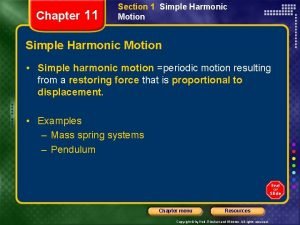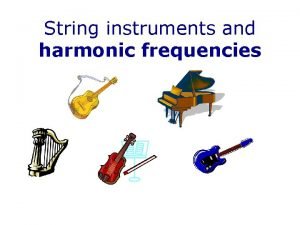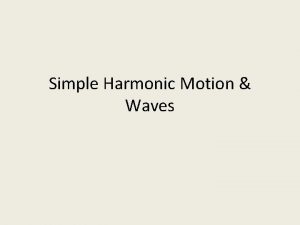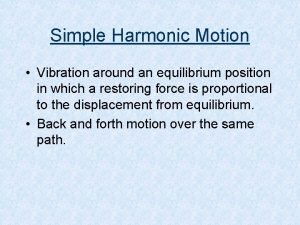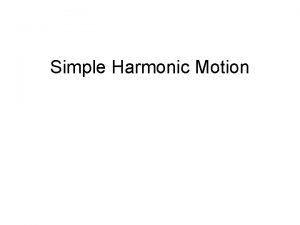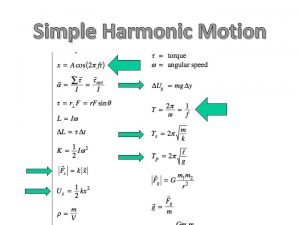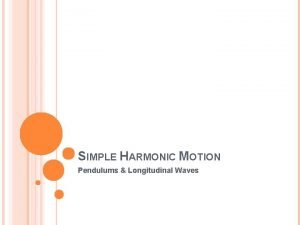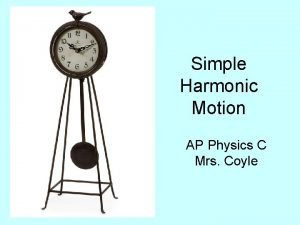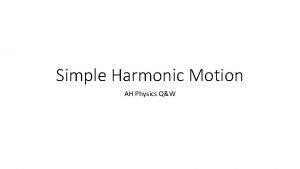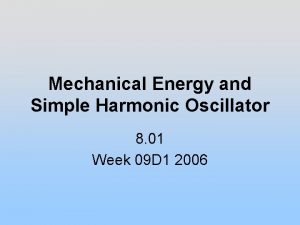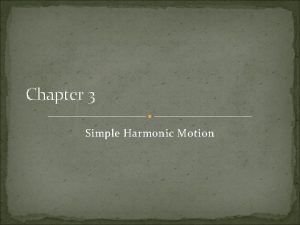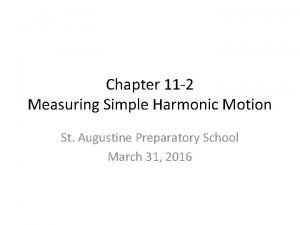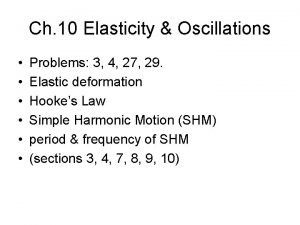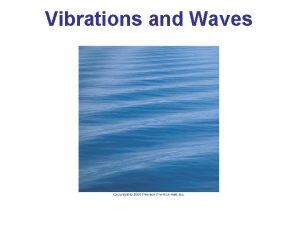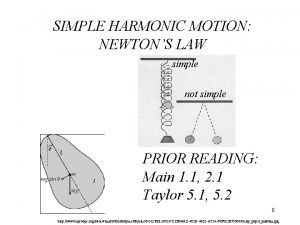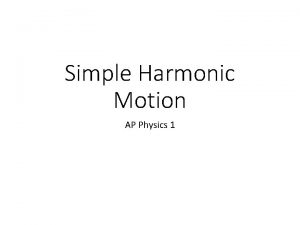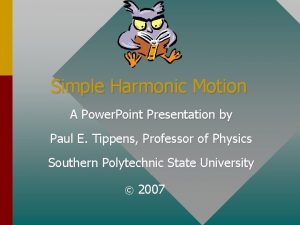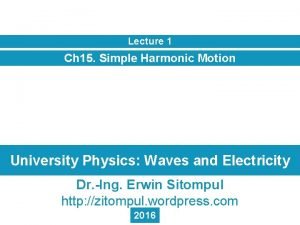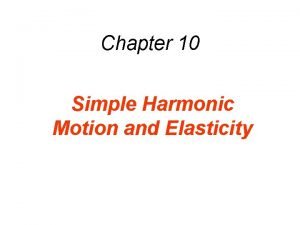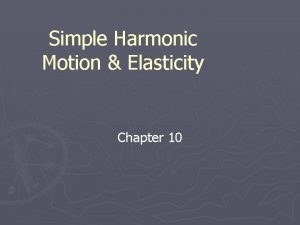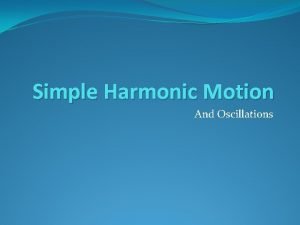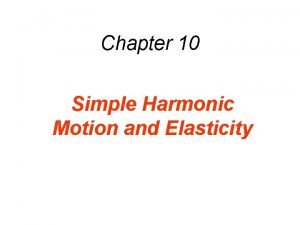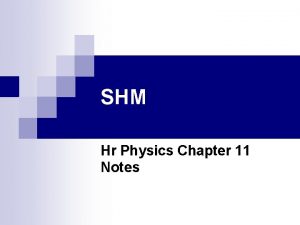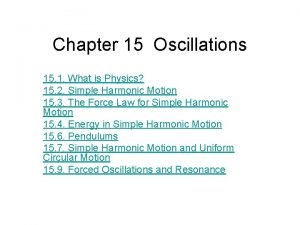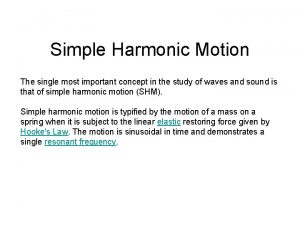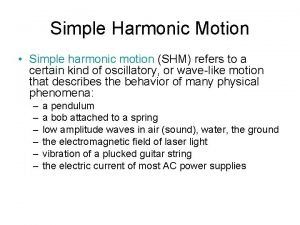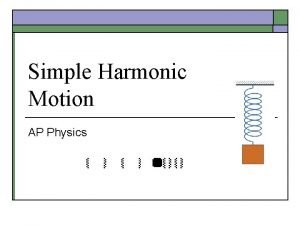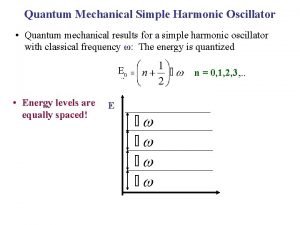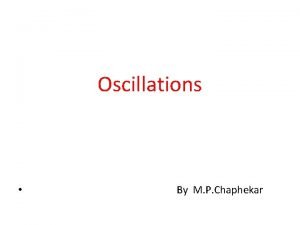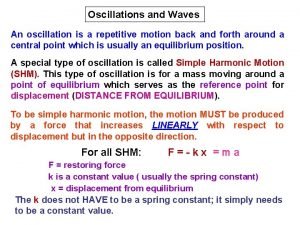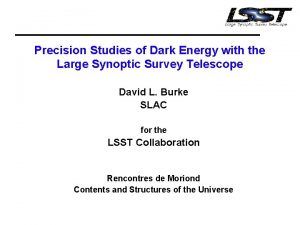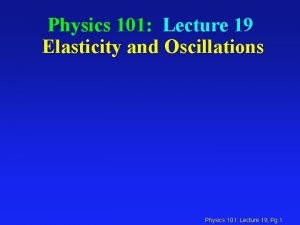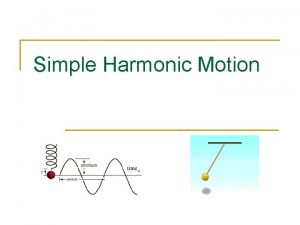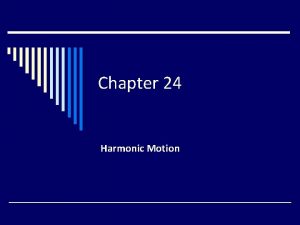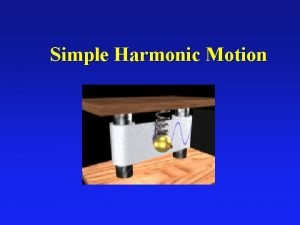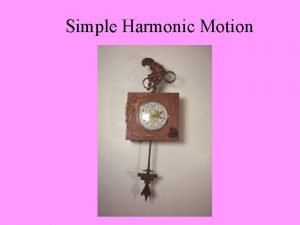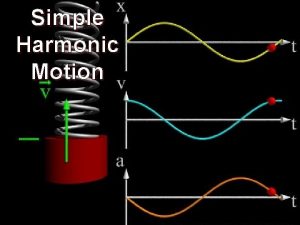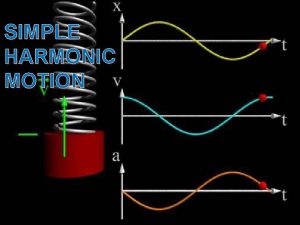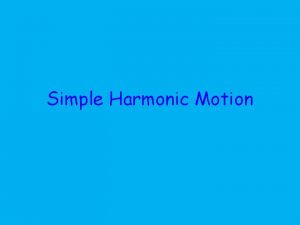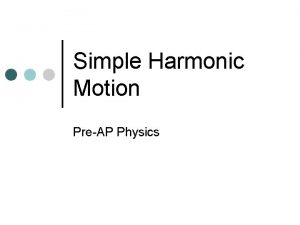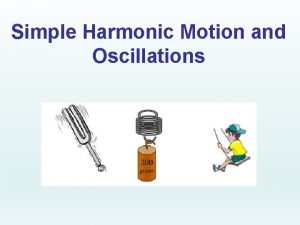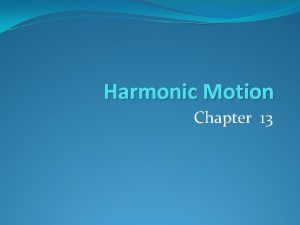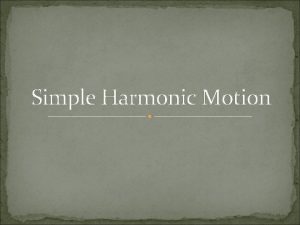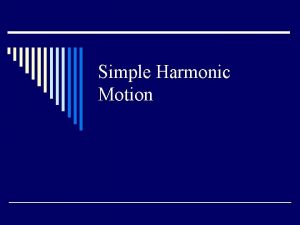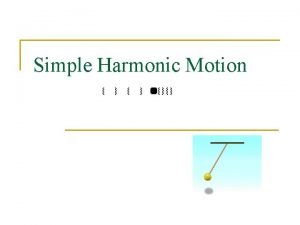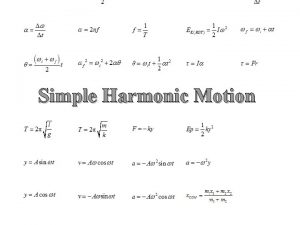Chapter 15 Oscillations Summary Simple harmonic motion Hooks





































- Slides: 37

Chapter 15 Oscillations

Summary • • Simple harmonic motion Hook’s Law Energy Pendulums: Simple. Physical, Meter stick

Simple Picture of an Oscillation x Frictionless surface F = -kx x

SHM in vertical position mg=kx x 0 x’ x Mg x= x’+ x 0 Equilibrium position with x 0=mg/k

Definitions

T=2 T’ T = 2π/ω Some Sample wave patterns x = xm cos (ωt) x = xm cos (ωt-π/4) We say the pink curve lags the blue one by 45 degrees

Relationships among x, v, and a and time dependence

Energy as a function of t and x

Simple Harmonic Motion Summary

Using Excel to solve numerically mass on a spring 1. 0 m ) In Excel

Excel Mass on a spring

Same as Problem 59 Ch 15

Period =2. 7 s 1/3 reduction 22 s

What is the effective spring constant? k k F=-kx-kx=-2 kx keff=2 k

What is the effective spring constant. k 1 k 2 F= -keff x= - k 1 x - k 2 x keff = - k 1 - k 2

Pendulum using rotational variables θ r L=r Fg Negative sign- clockwise rotation For small angles

pendulum continued Moment of inertia for a ball on a massless string of length L

Pendulum

Shows the difference in results using the sin theta = theta approx.


Physical Pendulum Replace L with h Note h is the distance between the pivot point and the center of mass

Challenge How do you find the point on a physical pendulum called the center of percussion or oscillation where the rotational motion is cancelled by the translational motion? If you suspend the pendulum from a point, then the distance to the CP is the same length as a simple pendulum to have the same period.

Meter stick pendulum T=1. 62 s for L =1 m and g =10 m/s 2 What is point CP again. It is where the rot. motion is canceled by the trans if you strike it at O. It is also the point where a simple pendulum of length OP would have the same period as the meter stick. L 0= 2/3 L. Note CP = 1/2 L -2/3 L =1/6 L.

Torsional pendulum t= - k θ where k is called a torsional constant dependent on the wire properties Used in watches Used to measure gravity (Cavendish) Used to measure Coulombs Law (MAPE next year)

a) Find the moment of inertia about the pivot point? b) What is the distance between center of mass and pivot point? c) Find the period of oscillation? mr=. 27 kg md=. 5 kg

Find the period of a helium balloon whose buoyant force is 5% more than mg of the balloon? L Neglect Air Friction

Damped simple harmonic oscillator with applied force and Resonance Attach the mass on the left to a motor that moves in a circle F Demo example with applied force and a dampening force. Air acts as the dampening force. The motor is the applied force.

Concep. Test 13. 1 a Harmonic Motion I A mass on a spring in SHM has amplitude A and period T. What is the total distance traveled by the mass after a time interval T? 1) 0 2) A/2 3) A 4) 2 A 5) 4 A

Concep. Test 13. 3 a Spring Combination I A spring can be stretched a distance of 60 cm with an applied force of 1 N. If an identical spring is connected in parallel with the first spring, and both are pulled together, how much force will be required to stretch this parallel combination a distance of 60 cm? 1) 2) 3) 4) 5) 1/4 N 1/2 N 1 N 2 N 4 N

Concep. Test 13. 5 a Energy in SHM I A mass oscillates in simple harmonic motion with amplitude A. If the mass is doubled, but the amplitude is not changed, what will happen to the total energy of the system? 1) total energy will increase 2) total energy will not change 3) total energy will decrease

Concep. Test 13. 5 a Energy in SHM I A mass oscillates in simple harmonic motion with amplitude A. If the mass is doubled, but the amplitude is not changed, what will happen to the total energy of the system? 1) total energy will increase 2) total energy will not change 3) total energy will decrease

Concep. Test 13. 9 Grandfather Clock A grandfather clock has a weight at the bottom of the pendulum that can be moved up or down. If the clock is running slow, what should you do to adjust the time properly? 1) move the weight up 2) move the weight down 3) moving the weight will not matter 4) call the repair man

Concep. Test 13. 1 a Harmonic Motion I A mass on a spring in SHM has amplitude A and period T. What is the total distance traveled by the mass after a time interval T? 1) 0 2) A/2 3) A 4) 2 A 5) 4 A In the time interval T (the period), the mass goes through one complete oscillation back to the starting point. The distance it covers is: A + A + A (4 A).

Concep. Test 13. 3 a Spring Combination I A spring can be stretched a distance of 60 cm with an applied force of 1 N. If an identical spring is connected in parallel with the first spring, and both are pulled together, how much force will be required to stretch this parallel combination a distance of 60 cm? 1) 2) 3) 4) 5) 1/4 N 1/2 N 1 N 2 N 4 N Each spring is still stretched 60 cm, so each spring requires 1 N of force. But since there are two springs, there must be a total of 2 N of force! Thus, the combination of two parallel springs behaves like a stronger spring!!

Concep. Test 13. 5 a Energy in SHM I A mass oscillates in simple harmonic motion with amplitude A. If the mass is doubled, but the amplitude is not changed, what will happen to the total energy of the system? 1) total energy will increase 2) total energy will not change 3) total energy will decrease The total energy is equal to the initial value of the elastic potential energy, which is PEs = 1/2 k. A 2. This does not depend on mass, so a change in mass will not affect the energy of the system. Follow-up: What happens if you double the amplitude?

Concep. Test 13. 5 a Energy in SHM I A mass oscillates in simple harmonic motion with amplitude A. If the mass is doubled, but the amplitude is not changed, what will happen to the total energy of the system? 1) total energy will increase 2) total energy will not change 3) total energy will decrease The total energy is equal to the initial value of the elastic potential energy, which is PEs = 1/2 k. A 2. This does not depend on mass, so a change in mass will not affect the energy of the system. Follow-up: What happens if you double the amplitude?

Concep. Test 13. 9 Grandfather Clock A grandfather clock has a weight at the bottom of the pendulum that can be moved up or down. If the clock is running slow, what should you do to adjust the time 1) move the weight up 2) move the weight down 3) moving the weight will not matter 4) call the repair man properly? The period of the grandfather clock is too long, so we need to decrease the period (increase the frequency). To do this, the length must be decreased, so the adjustable weight should be moved up in order to shorten the pendulum length. T = 2 p (L / ) g
 Shm
Shm Simple harmonic motion chapter 11
Simple harmonic motion chapter 11 Wave
Wave Simple harmonic motion vocabulary
Simple harmonic motion vocabulary Simple harmonic motion equilibrium position
Simple harmonic motion equilibrium position Spring constant
Spring constant Shm reference circle
Shm reference circle Simple harmonic motion formula
Simple harmonic motion formula Harmonic motion formula physics
Harmonic motion formula physics Shm
Shm Frequency of oscillation
Frequency of oscillation Simple harmonic oscillator
Simple harmonic oscillator Euler cromer method pendulum
Euler cromer method pendulum Measuring simple harmonic motion
Measuring simple harmonic motion Frequency in simple harmonic motion
Frequency in simple harmonic motion Simple harmonic motion formula
Simple harmonic motion formula Energy of simple pendulum
Energy of simple pendulum Simple harmonic motion ap physics 1
Simple harmonic motion ap physics 1 Simple harmonic motion presentation
Simple harmonic motion presentation Simple harmonic motion lecture
Simple harmonic motion lecture Simple harmonic motion and elasticity
Simple harmonic motion and elasticity Simple harmonic motion and elasticity
Simple harmonic motion and elasticity Kinematics of simple harmonic motion
Kinematics of simple harmonic motion Harmonic
Harmonic A trapeze artist swings in simple harmonic motion
A trapeze artist swings in simple harmonic motion K=mω^2
K=mω^2 What is simple harmonic motion
What is simple harmonic motion Simple harmonic motion energy equation
Simple harmonic motion energy equation Simple harmonic motion
Simple harmonic motion Simple harmonic motion definition
Simple harmonic motion definition Simple harmonic motion
Simple harmonic motion Harmonic oscillator
Harmonic oscillator Differential equation of shm
Differential equation of shm Simple harmonic motion
Simple harmonic motion Simple harmonic motion lecture
Simple harmonic motion lecture Baryon acoustic oscillations
Baryon acoustic oscillations Elasticity and oscillations
Elasticity and oscillations Sustained translatory joint play techniques
Sustained translatory joint play techniques

